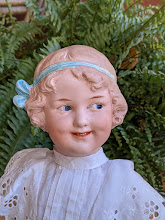Most of the problems that plague this type of doll are about to be seen here....
The area around the eye is prone to damage.
Her one eye socket is chipped and the other......well the whole eye is gone.
Something is rattling around inside the head. I hope that is the missing eye!
The cloth used for these bodies is typically a very thin cotton prone to fraying and ripping.
The arm cloth on this doll is almost non-existent. Actually her whole right arm is non-existent.
This particular doll has an interesting hole in it's side leading into a cardboard tube. I sense I am going to be finding some sort of mechanism inside.
The lower legs were being held on only by socks that were pinned to the upper legs. At least the lower legs are still present.
The back of the doll's head looks quite damaged under all that cloth and string.
Sure enough......lots of damage was being covered up by that cloth.
Happily the missing eye was inside the head!
This papier mache is quite thin and is obviously easily damaged.
Further disassembly finds the mysterious mechanism that the hole led to.
The doll once had 2 strings coming out of that hole. Pulling the strings operated a bellows type mechanism to produce a sound.
This is what was considered hi-tech at the turn of the 20th century!
The head is making progress in that the pieces are back together.
Now on to disguising the scars.....
So far she has gotten her voicebox repaired and re-installed, her feet mended and re-attached. Her replacement right arm is taking shape too.
Disguising the scars involves spraying sealer....which should not get onto the glass eyes.
And, this doll's hair is not removable without destroying it.
So, she gets a head-wrap to protect her hair and lovely blue goggles to protect her eyes.
Her current backside view.
She is now cleaned up and her scars are disguised.
Next is contemplating what to do with her hair. It is mohair and original to her so it would be nice to keep it.
This type of wig is sometimes called a 'topknot' wig. It was made by stuffing a handful of mohair into a hole on the top of the head. The mohair was then spread around the head, glued down and styled. This type of wig is very prone to losing mohair and often end up looking sparse and straggly.
I could resort to what many folks do on a bad hair day.....put on a hat.
Or, maybe extensions would work? I install several extensions by gluing in multiple small clumps of a similar coloured mohair.
Then she goes off to the doll hair salon.
Here is one of her arms getting stuffed.
The piece of cloth someone had used to hold her head pieces on was big enough to make new upper arms. And, it was the same style of antique cotton.
The stuffing is excelsior, or wood wool. This was a common stuffing used in the era this doll was made. The body and legs are stuffed with excelsior so the arms, ideally should be too.
All back together and waiting for her clothes....


















Beautiful job by a very talented doll doctor. I certainly enjoyed this lesson in “doctoring”. Thank you so much
ReplyDeleteWonderful! I have a similar doll with partially similar problems. My doll has a very strong "carrot" colour which looks a bit strange for me. Maybe the sealing is los.
ReplyDelete